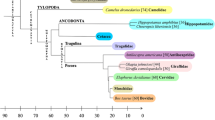Abstract
Cross-species reciprocal chromosome painting was used to determine homologous chromosomal regions between the laboratory mouse and Chinese hamster. When mouse chromosome-specific paints were hybridized to Chinese hamster chromosomes, paints specific for mouse chromosomes 3, 4, 9, 14, 18, 19 and X each painted a single chromosomal region, whilst other mouse paints delineated multiple discrete chromosomal regions. The mouse Y paint produced non-specific signals on Chinese hamster chromosomes. Nineteen mouse autosome paints identified a total of 47 homologous chromosome regions in the genome of the Chinese hamster. Hybridization of Chinese hamster paints to mouse chromosomes not only confirmed the above results, but also identified which of the chromosomal regions of these two species were homologous. In total, 10 Chinese hamster autosomal paints detected 38 homologous autosomal segments in the mouse genome. A comparative chromosome map was established based on these reciprocal chromosome painting patterns. This map forms the basis for exchanging gene mapping information between the species and for studying genome evolution.
Similar content being viewed by others
References
Baron B, Fernandez MA, Toledo F et al. (1994) The highly conserved Chinese hamster GNAI3 gene maps less than 60 kb from the AMPD2 gene and lacks the intronic U6 snRNA present in its human counterpart. Genomics 24: 288–294.
Carter NP, Ferguson-Smith ME, Affara NA, Briggs H, Ferguson-Smith MA (1990) Study of X chromosome abnormality in XX males using bivariate flow karyotype analysis and flow sorted dot blots. Cytometry 11: 202–207.
Carter NP, Ferguson-Smith MA, Perryman MT et al. (1992) Reverse chromosome painting: a method for the rapid analysis of aberrant chromosomes in clinical cytogenetics. J Med Genet 29: 299–307.
Copeland NG, Jenkins NA, Gilbert DJ et al. (1993) A genetic linkage map of the mouse: Current applications and future prospects. Science 262: 57–66.
Davisson MT, Akeson EC (1987) An improved method for preparing G-banded chromosomes from mouse peripheral blood. Cytogenet Cell Genet 45: 70–74.
Davisson MT, Bradt DW, Merriam JJ, Rockwood SF, Eppig JT (1998) The mouse gene map. ILAR J 39: 96–131.
Eppig JT, Nadeau JH (1995) Comparative maps: the mammalian jigsaw puzzle. Curr Opin Genet Devel 5: 709–716.
Ferguson-Smith MA (1997) Genetic analysis by chromosome sorting and painting: phylogenetic and diagnostic applications. Eur J Hum Genet 5: 253–265.
Ferguson-Smith MA, Yang F, O'Brien PCM (1998) Comparative mapping using chromosome sorting and painting. ILAR J 39: 68–76.
Graphodatsky AS (1988) Conserved and variable elements of mammalian chromosomes. In: Halnan CRE, ed. Cytogenetics of Animals. Wallingford: C.A.B. International, pp 95–123.
Gruètzer F, Himmelbauer H, Paulsen M, Ropers H-H, Haaf T (1999) Comparative mapping of mouse and rat chromosomes by fluorescence in situ hybridisation. Genomics 55: 306–313.
Guilly M-N, Fouchet P, de Chamisso P, Schmitz A, Dutrillaux B (1999) Comparative karyotype of rat and mouse using bidirectional chromosome painting. Chromosome Res 7: 213–221.
Hsu TC, Arrighi FE (1971) Distribution of constitutive heterochromatin in mammalian chromosomes. Chromosoma 34: 243–253.
Mouse Genome Database (MGD), Mouse Genome Informatics, The Jackson Laboratory, Bar Harbor, Maine. <http:// www.informatics.jax.org> September 1999.
Murer-Orlando M, Richer CL (1983) Heterochromatin heterogeneity in Chinese hamster sex bivalents. Cytogenet Cell Genet 35: 195–199.
O'Brien SJ, Womack JE, Lyons LA, Moore KJ, Jenkins NJ, Copeland NG (1993) Anchored reference loci from comparative genome mapping in mammals. Nat Genet 3: 103–112.
Rabbitts P, Imply H, Heppell-Parton A et al. (1995) Chromosome specific paints from a high resolution flow karyotype of the mouse. Nat Genet 9: 369–375.
Ray M, Mohandas T (1976) Proposed banding nomenclature for the Chinese hamster chromosomes (Cricetulus griseus). Cytogenet Cell Genet 16: 83–91.
Satoh H, Yoshida MC (1985) Gene mapping in the Chinese hamster and conservation of syntenic groups and q-banding homologies between Chinese hamster and mouse chromosomes. Cytogenet Cell Genet 39: 285–291.
Scherthan H, Cremer T, Arnason U, Weier HU, Lima-de-Faria A, Fronicke L (1994) Comparative chromosome painting discloses homologous segments in distantly related mammals. Nat Genet 6: 342–347.
Stanyon R, Yang F, Cavagna P et al. (1999) Reciprocal chromosome painting shows that genomic rearrangement between rat and mouse proceeds ten times faster than between humans and cats. Cytogenet Cell Genet 84: 150–155.
Telenius H, Pelmear AH, Tunnacliffe A et al. (1992) Cytogenetic analysis by chromosome painting using DOP-PCR amplified flowsorted chromosomes. Genes Chromosomes Cancer 4: 257–263.
Wienberg J, Stanyon R (1997) Comparative painting of mammalian chromosomes. Curr Opin Genet Devel 7: 784–791.
Wilkie TM, Gilbert DJ, Olsen AS et al. (1992) Evolution of the mammalian G protein alpha subunit multigene family. Nat Genet 1: 85–91.
Xiao Y, Slijepcevic P, Arkesteijng, Darroudi F, Natarajan AT (1996) Development of DNA libraries specific for Chinese hamster chromosomes 3, 4, 9, 10, X and Y by DOP-PCR. Cytogenet Cell Genet 75: 57–62.
Yang F, Carter NP, Shi L, Ferguson-Smith MA (1995) A comparative study of karyotypes of muntjacs by chromosome painting. Chromosoma 103: 642–652.
Yang F, Muèller S, Just R, Ferguson-Smith MA, Wienberg J (1997) Comparative chromosome painting in mammals: Human and the Indian muntjac (Muntiacus muntjak vaginalis). Genomics 39: 396–401.
Author information
Authors and Affiliations
Rights and permissions
About this article
Cite this article
Yang, F., O'Brien, P.C.M. & Ferguson-Smith, M.A. Comparative Chromosome Map of the Laboratory Mouse and Chinese Hamster Defined by Reciprocal Chromosome Painting. Chromosome Res 8, 219–227 (2000). https://doi.org/10.1023/A:1009200912436
Issue Date:
DOI: https://doi.org/10.1023/A:1009200912436




